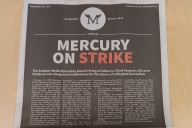You have /5 articles left.
Sign up for a free account or log in.
How Stella Saved the Farm: A Tale About Making Innovation Happen by Vijay Govindarajan and Chris Trimble
Published in March of 2013.
Everyone in higher ed seems to believe in the power of innovation, while very few of us know how to change how we organize ourselves to move from ideas to execution.
The best book that I have read about innovation in higher ed actually says very little about higher ed. It is The Other Side of Innovation: Solving the Execution Challenge by my colleagues Vijay Govindarajan and Chris Trimble.
The Other Side of Innovation has provided me a mental roadmap for my work as member of a dedicated team (a term from the book) that launched a new high quality graduate blended learning program within our larger organization.
When I speak to audiences about innovation within higher ed, inevitably I rely upon the lessons that I learned from The Other Side of Innovation. I usually end up making the point that they would all be better off reading the book than listening to me.
The problem is that as much as I evangelize for a book that changed both my thinking and my behavior, only a subset of folks will be able to find the time to read the book.
The people tasked with working on innovation projects are usually too busy (as they are often trying to squeeze these new initiatives in with their existing responsibilities.....one of the main pitfalls pointed out by the authors), and therefore reading a 240 page business book is a challenge.
Even if they do read the book its impact is muted, as unless leadership and other key players also concurrently read the book it is difficult for the ideas and recommendations to gain traction. Getting one person to read a book is enough of a challenge, try getting an entire leadership team!
Govindarajan and Trimble have attempted to solve this problem by coming out with a parable that boils down, without dumbing down, the central lessons of The Other Side of Innovation.
How Stella Saved the Farm is a beautifully illustrated and fast paced narrative on how to make innovation actually happen. A book that can be read and enjoyed in the time it takes most people to watch a rerun of Law and Order.
The business problem that How Stella Saved the Farm tackles is about how a small, animal-family run farm (trust me, it makes sense), can survive in an era of brutal competition from the increasingly corporate human-run farms.
What happens when achieving even greater levels of efficiency and productivity in your core business is no longer enough? (Sound familiar to our challenges in higher ed?)
What do we do when technology and new competitors have fundamentally re-written the rules of our business? (Again, sound familiar?)
How can an organization take a great idea about a new product or service beyond the idea stage without sacrificing the work, the revenue, and the reputation of the core organization?
As is clear by its title, all of the action in this parable takes place on a farm. Higher ed is never mentioned.
But we have just as pressing a need to innovate as the animal-farmers do in Stella.
We can keep working harder, keep trying to become more efficient, but in an era of free and limitless information, declining public funding, and emerging competitive models these efforts will most likely be insufficient to meet the challenges that we face.
Our postsecondary institutions are going to need to execute on some big ideas if we wish to remain relevant and solvent in the years to come.
My recommendation is that you give a copy of How Stella Saved the Farm to every member of any campus group that is discussing change.
Not only will all your colleagues thank you, they will actually read the book (as you will not stop reading this parable once you start).
How Stella Saved the Farm is concise, the story telling compelling, and the take-aways clear and actionable. The authors have generously created a website howstellasavedthefarm.com with a ton of great resources to guide discussion and to find additional materials on innovation.
Take a break for a day from talking about MOOCs and whatever else, and instead spend some time talking about farm animals.
Your conversation is guaranteed to be more productive, and you may even come up with a solid plan of how to move from talking to doing. (Always a challenge in our business).
What are you reading?








